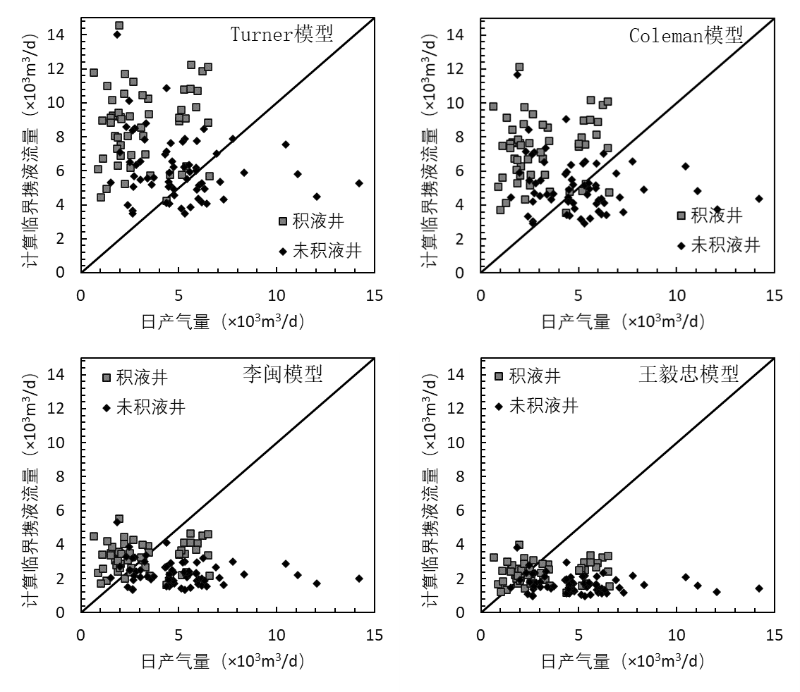中石化华北油气分公司采气一厂,河南郑州, 450006
摘要:国内外对于气井临界携液的研究已相对成熟,模型多但适用条件不同。选用合适的临界携液模型,对于大牛地气田判断气井积液状态、调整气井配产、制定气井工艺具有重要指导意义。文章结合121口大牛地气田不同井型、不同气藏单元、不同管柱结构气井的井底流压测试,系统研究了Turner、Coleman、李闽和王毅忠等4种常用模型在气田不同条件下的适用情况, Turner模型和Coleman模型计算临界携液流量偏大,Coleman模型略好于Turner模型,王毅忠模型计算临界携液流量偏小,积液井中判别误差大,综合正确率72.7%;李闽模型计算结果与实际数据更加吻合,积液井和未积液井判别效果均较好,综合正确率80.2%,更适用于大牛地气田。
关键词:大牛地气田;临界携液流速;临界携液流量;模型对比;李闽模型
Applicability analysis of critical liquid-carrying model in Daniudi gas field
Wen Honggang
No.1 Gas Production Plant, Huabei Company, Sinopec, Zhengzhou, Henan, 450006)
Abstract:The research on critical liquid-carrying in gas wells at home and abroad has been relatively mature, and there are many models but different applicable conditions. Selecting an appropriate critical liquid-carrying model has important guiding significance for judging the liquid accumulation state of gas wells, adjusting gas well production allocation, and formulating gas well technology in Daniudi Gas Field. Combined with the bottom-hole flow pressure tests of 121 gas wells with different well types, different gas reservoir units and different pipe string structures in the Daniudi gas field, this paper systematically studies the performance of four commonly used models including Turner, Coleman, Li Min and Wang Yizhong under different gas field conditions. Applicable situations, Turner model and Coleman model calculate critical liquid-carrying flow rate is too large, Coleman model is slightly better than Turner model, Wang Yizhong model calculates critical liquid-carrying flow rate is small, the judgment error in liquid accumulation wells is large, and the comprehensive accuracy rate is 72.7%; Li Min model The calculation results are more consistent with the actual data, and the discriminative effects of liquid-filled wells and non-liquid-filled wells are both good, with a comprehensive accuracy rate of 80.2%, which is more suitable for the Daniudi gas field.Keywords:Daniudi gas field; Critical liquid-carrying velocity; Critical liquid-carrying flow rate; Model comparison; Li Min model
引言
天然气常以气液两相流的形态从地层中产出。气井生产前期,地层能量足、气产量大,可以连续携液将液带出井口;随着气井的连续生产,地层能量下降,气产量无法满足携液条件,存在于井筒中的液滴和液膜回落至井底,在井底形成积液,进而影响气井生产能力,甚至使气井停产。
利用合适的临界携液模型准确判断井筒积液形势,可以通过调整配产、及时引进泡排等措施,缓解气井积液状况、改善气井生产能力、提高气井寿命。然而,随着临界携液研究的不断深入,不同的计算模型被广泛提出。各模型的提出前提及适用条件不同,寻找适用于大牛地气田的计算模型意义重大。
1 临界携液流量模型
天然气产出过程中,液体受重力和气体对其的浮力、曳力影响。当浮力和曳力之和大于液体所受重力,液体可被气体带出井筒。当浮力和曳力恰好等于其所受重力时,气体的流速达到临界携液流速,此时气井产量为临界携液流量。若气体的流速进一步降低,气流能量无法将无法使井筒中的液体连续流出,携液能力降低,导致液体回落聚集在井底,形成积液。
目前最为常用的临界携液流量计算模型有Turner模型、Coleman模型、李闽模型和王毅忠模型。1969年,R.G.Turner、M.G.Hubbard、A.E.Dukler等学者基于垂直管柱和高速气流携带液体为圆球型的假设,提出了经典的Turner模型[1]。1991年,Steve B.Coleman对Turner模型中进行了修正,建立了Coleman模型[2]。2001年,李闽教授认为在高速气流的作用下,气流携带的液滴前后存在的压差会导致液滴变形成椭球体,对Turner模型进行了改进[3]。2007年,王毅忠根据气井中运动的球帽形液滴,建立了球帽状液滴模型的最小携液临界流量计算公式。各临界携液流速和流量模型如表1所示[4]。
表1 4种常用临界携液模型对比表
模型 | 临界携液流速Vgc | 曳力系数Cd | 临界携液流量Qgc | 假设条件 |
Turner | | 0.44 | | 圆球形液体 |
Coleman | | 0.44 | 圆球形液体 | |
李闽 | | 1.0 | 椭球形液体 | |
王毅忠 | | 1.17 | 球帽形液体 |
2 研究区概况
大牛地气田是国内率先实现效益开发的致密低渗气田,具有低孔、特低渗、低压和低产的特点。截止2021年12月,气田拥有1762口气井,开井数1616口,平均油压2.1MPa,平均套压3.4MPa,日产天然气840万方/天,平均单井产气0.52万方/天,液气比1.66方/万方。2009年以来,气田的气井压力逐年降低。至2021年12月,气田小于1.6MPa气井井数占比48%,产量占比36%,产量小于0.6万方气井井数占比73%,产量占比41%,低压低产井占比大,已有约83.29%的生产井采用泡沫排水工艺[5]。
3 模型对比
选取121口在2021年测试过井底流压的直井,其中积液井54口,占比44.6%,未积液井67,占比55.4%,通过对比实际积液情况和4种模型判断结果分析各模型适用性。各模型计算临界携液流量和实际气井日产气量如图1所示。

图1实际产气量于不同临界携液流量模型计算值对比图
图1中对角线上方为积液区域,对角线以下为未积液区域。图1表明Turner模型和Coleman模型计算临界携液流量偏大,Coleman模型略好于Turner模型,未积液井使用上述两模型判别误差大,综合正确率分别为62.0%和70.2%;王毅忠模型计算临界携液流量偏小,积液井中判别误差大,综合正确率72.7%;李闽模型计算结果与实际数据更加吻合,积液井和未积液井判别效果均较好,综合正确率80.2%,更适用于大牛地气田。
4 结论
根据大牛地气田121口井底流压测试资料,通过对比Turner、Coleman、李闽和王毅忠四种常用临界携液模型的判别结果与实际积液情况,发现Turner模型和Coleman模型计算临界携液流量相较气井实际所需最小排液产量偏大,王毅忠模型计算临界携液流量偏小,李闽模型与实际数据更加吻合。四种模型中,李闽模型更适用于大牛地气田目前的生产实际,积液预测精度达80.2%。
参考文献
Coleman S B,Clay H B, McCurdy, et al. A new look at predicting gas-well load-up[R]. SPE 20280,1991:329-333.
Turner R G,Hubbard M G,Dukler A E. Analysis and prediction of minimum flow rate for the continuous removal of liquids from gas wells[J]. Journal of Petroleum Technology,1969,21(11):1475-1482.
李闽,郭平,谭光天.气井携液新观点·石油勘探与开发[J].2001,28(5):105-106.
王毅忠,刘庆文.计算气井最小携液临界流量的新方法[J].大庆石油地质与开发,2007,26(6):82-85.
宋玉龙,杨雅惠,曾川,丁磊,赵润东,袁玥.临界携液流量与流速沿井筒分布规律研究[J].断块油气田,2015,22(01):90-93+97.